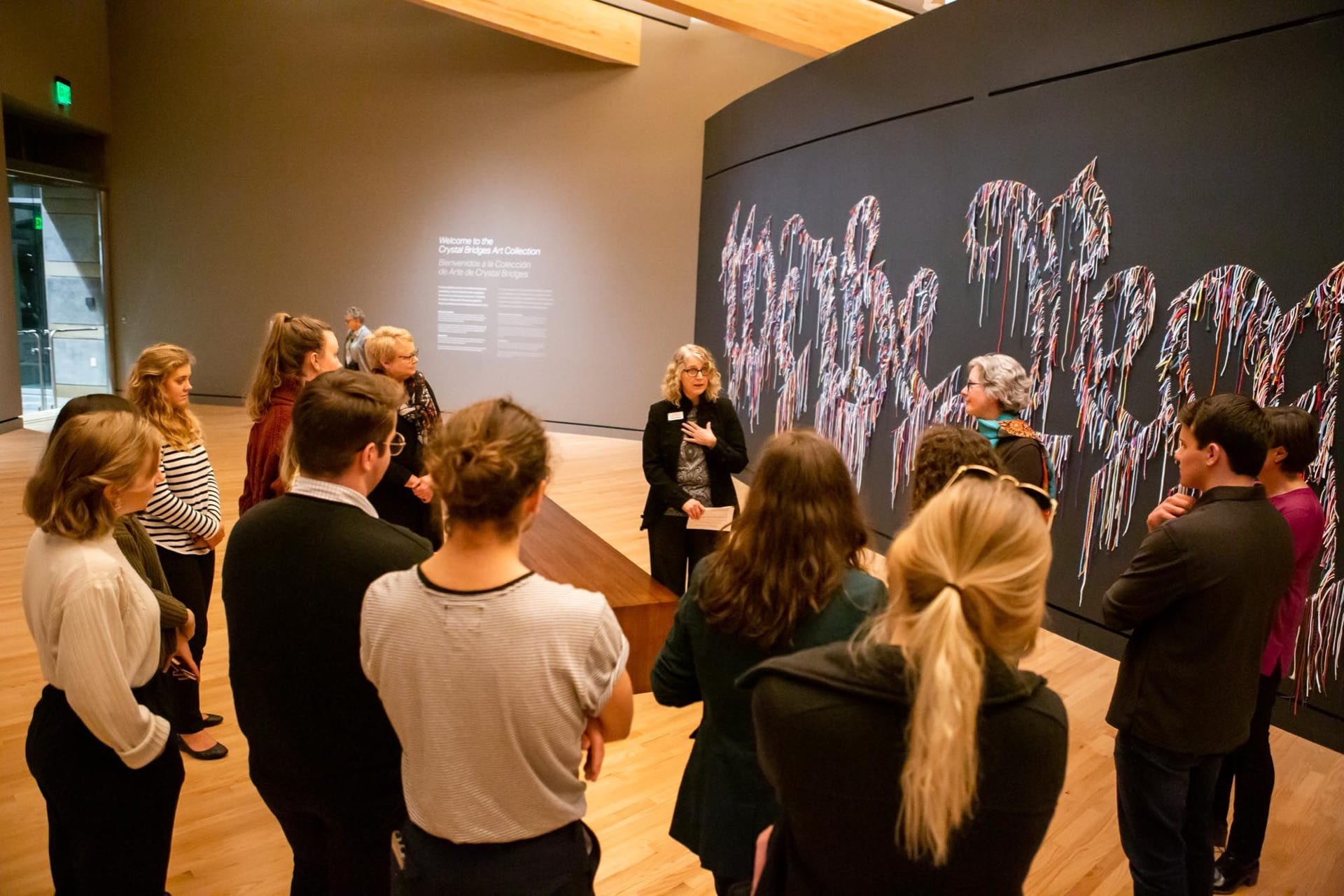
Robin Groesbeck, Crystal Bridges’ director of exhibitions and interpretation takes honors students on a tour of the museum’s new entrance gallery. Photo: Daniel Moody.
In this latest post from one of the “Museum 12” who participated in our Museum forum, Sydney Nichols unpacks the new entrance gallery to Crystal Bridges Museum of American Art. She responds to the unorthodox mix of portraits, affirms the impact of bilingual messaging and finds one missed opportunity. Sydney is a freshman Bob and Ruth Shipley Fellow from the University of Arkansas Honors College majoring in art history and English with a concentration in creative writing. Originally from Marion, Arkansas, she is interested in the literary and artistic expressions of the American South. After college she hopes to pursue a graduate degree in contemporary art and museum studies.
Peeking through the glass doors of Crystal Bridges’ Early American Gallery, the “Museum 12” first notices color exploding from the wall. Upon walking through these doors, we recognize a pattern; rendered in shoelaces and dominating the wall is the household phrase: “We the People.” Turning around, the opening words of our constitution and the notions of tradition they evoke are dismantled by a diverse group of portraits completed in years ranging from 1780 to 2013. George Washington the president hangs next to a minute-long video portrait of Johnny the oil and natural gas worker, dressed in camouflage and displaying his loyalty to the Denver Broncos. Norman Rockwell’s Rosie the Riveter hangs next to a portrait of civil rights activist Hugh Hurd by Alice Neel. Within the first hundred feet of the museum, Crystal Bridges has loosely collected these works under the theme of portraiture, leading you to the loaded question: What does it mean to be American?
To prepare for this past week’s class, our teachers, Director of Exhibitions & Interpretation Robin Groesbeck and Head of Public Programs Janelle Redlaczyk assigned an article about the role museums have adopted as “social change agents.” Previously seen narrowly as “an archive for artifacts,” today’s successful museum contextualizes art—old and modern—in the larger discussions and concerns of society. In 2019, it seems the question is no longer if museums should engage in political conversations but how they can do so effectively.
Towards the end of 2017, Crystal Bridges committed themselves to reimagining their Early American Gallery, this first gallery you are ushered into while visiting the museum. They made bold strides while rearranging the gallery, including the unique juxtapositions of portraiture I mentioned earlier and panels translating all explanations of the gallery and its art into Spanish. Written into the introductory panel of the gallery is the earnest phrase
“There is no single narrative of American art and history.”
Viewing this all at once, it was hard not to become emotional, especially after previous class discussions concerning the lack of diversity among museum visitors—a global trend that also manifests at Crystal Bridges. This sort of statement succeeds in catalyzing conversation because it is appropriate to Crystal Bridges. As the article we read explained, social progressive exhibits are best received when they “have a contextual connection to the institution itself.” The museum’s mission defines them as concerned with the “American Spirit” and welcoming all, and our class’ walk through the gallery made that abundantly clear. Knowing, of course, that there is still room for improvement, Groesbeck and Redlaczyk challenged us to critique aspects of their displays that we thought failed to live up to the gallery’s intention of generating social change.

Sydney Nichols (right) and Emily Snyder consider Charles Bird King’s portraits of Cherokee Nation leaders.
My partner and I settled on a group of portraits completed by Charles Bird King. In the nineteenth century, King was commissioned by the government to create portraits of distinguished Native Americans. Two of these portraits display individuals in dress archetypal of illustrations of Native Americans, but the third portrait shows someone in garb reminiscent of European-American colonials. The gallery’s text panel for the portrait explains that this is the Portrait of John Ridge, a member of a “prominent family of the Cherokee Nation.” By grouping these three portraits by Bird without addressing this stark contrast of dress, we think that Crystal Bridges misses an opportunity to comment on the motives of the American government in commissioning these paintings. As art often outlasts individual stories, representing Ridge peacefully in European-American clothing effectively rewrites the oppression inflicted upon Native Americans by the colonials. The panel explains Ridge’s dress as a choice and a product of his education, but we figured this would be an apt place to comment on colonizers’ stifling attempt to assimilate native peoples.
Leaving Crystal Bridges that night, I felt as if my entire perspective of museums and their exhibits had changed. No longer are they just places to reflect on tokens of the past; they are spaces ripe for the discussion of contentious topics and the promotion of dismissed voices.
